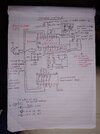Hi Guys, I have a four touch operated Single pole change over light switches that can control a light from two locations.
one pair is faulty, I spent hours drawing the circuit out and proved it's the main 18 pin chip that it faulty, to prove it I de soldered one from one of the spare switches and now it works, trouble is I cannot identify the chip to buy a replacement.
The chip is smd and has 18 pins, there are no crystals or ceramics so I don't think it's a pic chip and there are no wave forms on the pins with the scope, just DC voltages, so I think it's linear, it
has FMD at the top and under it B2C50DE or it might be ode but either way I find nothing on the net, anyone got any idea's please. Bob
one pair is faulty, I spent hours drawing the circuit out and proved it's the main 18 pin chip that it faulty, to prove it I de soldered one from one of the spare switches and now it works, trouble is I cannot identify the chip to buy a replacement.
The chip is smd and has 18 pins, there are no crystals or ceramics so I don't think it's a pic chip and there are no wave forms on the pins with the scope, just DC voltages, so I think it's linear, it
has FMD at the top and under it B2C50DE or it might be ode but either way I find nothing on the net, anyone got any idea's please. Bob
Last edited:


